Useful and harmful properties of red cabbage
Red cabbage is popular in cooking. It is consumed fresh, pickled and stewed. The description contains information about the benefits of red cabbage for the body.
- Description
- Composition
- Energy value
- What is the usefulness
- The nutritional value of the juice
- Contraindications
- Application
- Growing features
- Seed preparation and sowing
- Features of seedling care
- Transfer to the site
- Planting care
- Harvesting
- Varieties
- Vanguard f1
- Anthracite F1
- Auto F1
- Boxer
- Benefit
- Vorox
- Gako
- Nurima
- Stone head 477
- Kalybos
- Mars
- Victory
- Faberge
- Varna
- Ruby ms
- Conclusion
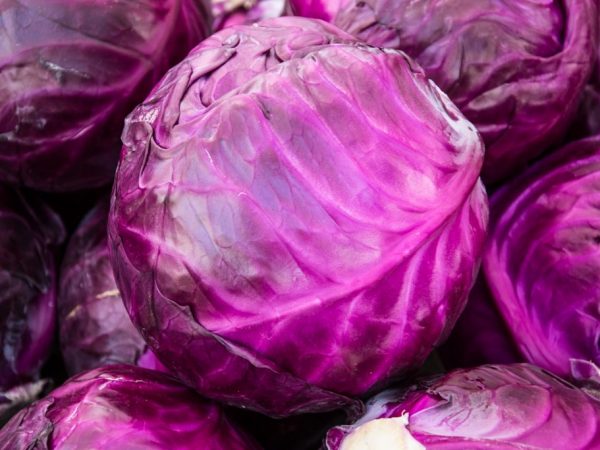
Useful and harmful properties of red cabbage
Description
The structure of the structure, taste and appearance of the vegetable is the same as that of white cabbage. The only difference is the chemical composition and color of the vegetables. The harvest of the heads of this culture is red or purple, which is why it is called red.
Composition
In red cabbage, the chemical composition is much richer. The garden beauty contains vitamins and minerals necessary for human health. Not all varieties of this vegetable have such a balanced composition of nutrients:
- all B vitamins;
- vitamins PP, A, E, C, N.
Red cabbage (or purple cabbage) contains a high dose of iron, potassium, calcium, sodium, and magnesium. These essential micronutrients are extremely important for the health of both women and men.
According to the biological description, the culture has unique properties:
- useful for children and recommended for use from the age of 1 year;
- contains a daily dose of vitamin C and, with regular use, compensates for its deficiency;
Energy value
The calorie content of the product is very low. 100 g contains 23 kcal, so red cabbage can be safely included in the diet. The ratio of BJU: a large dose of protein and little fat and carbohydrates.
What is the usefulness
The beneficial properties of red cabbage are more apparent when eaten raw.
The benefits of red cabbage for humans:
- increases the elasticity of blood vessels;
- the intestines are cleansed of toxins;
- normalizes blood pressure;
- removes harmful cholesterol from the body;
- prevents the development of cancer;
- enhances immunity;
- eliminates puffiness (the vegetable has a diuretic effect);
- normalizes the digestive system.
The nutritional value of the juice
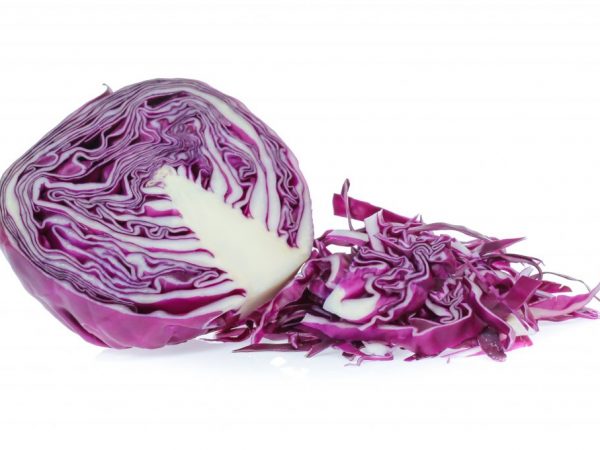
Cabbage juice has medicinal properties
Red cabbage juice has unique medicinal properties:
- heals wounds, so it is used internally to treat ulcers and gastritis;
- has an antibacterial effect;
- helps in the treatment of tuberculosis.
Red cabbage juice has a beneficial effect on the growth and development of a young organism, increases immunity, so it is included in baby food.
Red cabbage juice improves the condition of the skin, nails and teeth, makes the skin velvety, soft and fresh.
Red cabbage juice is especially valuable for women. Hair rinses are made from it. These treatments improve the condition of the hair, retain its color and give it vitality and shine.Freshly squeezed juice is diluted with water in a ratio of 1: 0.5 l.
Contraindications
There are some contraindications for eating red cabbage:
- allergic reactions;
- pregnancy;
- urolithiasis, indigestion and flatulence;
- the period of breastfeeding (the product provokes colic in the baby).
Fresh red cabbage puree is introduced into the diet for children from the age of six months.
Application
The variety of red cabbage has fewer carbohydrates than other varieties, it is allowed to be consumed with diabetes mellitus.
Red cabbage or lilac cabbage is of great value in cooking. A wide variety of dishes are prepared from it.
Salads are prepared from red cabbage. This vegetable goes especially well with canned corn. There are also side dishes, first and second courses. The product is fermented, baked, but fresh red cabbage is most useful. This product contains 100% composition of all useful components.
Marinated, this product is an excellent addition to any type of meat.
Growing features
Growing this culture is not difficult at all. Planting is done both by seedlings and seeds.
Seed preparation and sowing
You can buy seed material at any gardening store. The seeds are sorted out, the bad ones are discarded, then soaked in warm, and then in cold water. After hardening, the seeds are dried, dipped in Epin's solution for several hours, then dried again.
Seeds are planted in loose and fertile soil from turf, garden soil, sand and rotted manure. Also, an earthy mixture for planting seeds can be purchased at a specialized store.
Sowing seeds for seedlings is carried out in late March-early April in seedling boxes.
Features of seedling care
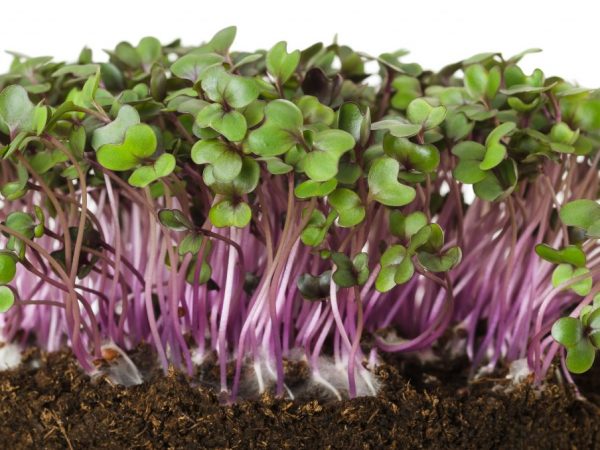
Seedlings must dive
Until the sprouts appear, the planted seeds are shaded, periodically sprayed. The air temperature should not exceed 10 ° С, humidity - 80-90%.
As soon as the sprouts break through the ground, boxes with seedlings are brought out into the light, protecting from the scorching sun. They are periodically watered, the soil is loosened.
At the stage of appearance of one pair of leaves, the sprouts dive into separate containers. For these purposes, peat tablets are used.
Transfer to the site
Transplanting purple cabbage is carried out exactly 2 months after sowing the seeds. By this time, the seedlings release 2-3 pairs of leaves, the heat stabilizes on the street.
Planting is carried out in loose, slightly acidic soil, fertilized with dressings. Nutrition and digging of the site for planting this culture are carried out in the fall. Sprinkle the soil with organic fertilizer, then dig it up.
1 tbsp is added to each well. l. fertilizers, then the top dressing is mixed with the ground, and the seedlings, together with a peat tablet, are placed in a dug hole, watered abundantly, sprinkled with soil and slightly trampled.
Planting care
Red cabbage needs careful maintenance to produce a tasty and good harvest.
Plants are regularly watered, loosened, mulched with peat or straw, and also 3 times per season are fed.
The first feeding is carried out 14 days after transplanting the shoots into the open ground. For these purposes, chicken droppings are used: 1 liter of the substance is dissolved in 20 liters of water.
The second feeding of red cabbage is carried out after another 2 weeks with the same solution as in the first case.
The last meal is carried out one month before harvest. Plants are fed with drugs with a high nitrogen content.
Harvesting
The ripeness of the heads of cabbage and the period when they need to be removed from the garden are determined by their density. If the purple beauty is not hard, it is not yet ripe. Usually, early varieties are harvested in the first decade of August for fresh consumption. Cut off late varieties for winter consumption in September.
If ripe red cabbage has become soft, the technology of its cultivation has been disrupted or the plants have been affected by some kind of disease.
Varieties
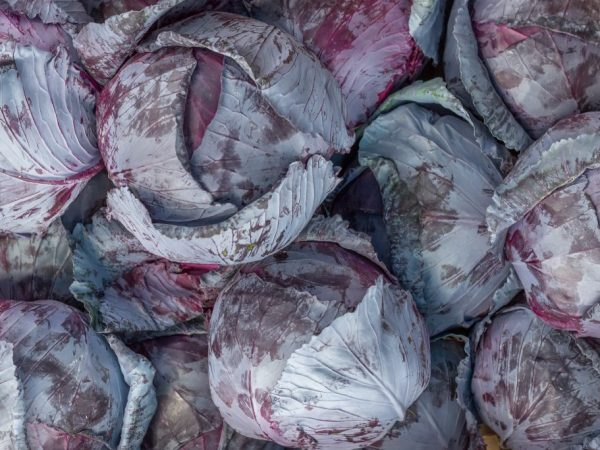
There are many varieties of red cabbage
Every year, breeders bring out new varieties of red vegetables. At the same time, the harvest is of high quality and tasty.
Vanguard f1
Vanguard f1 is a mid-season purple cabbage variety with leaves collected in a vertical rosette. The leaves are large, blue with a greenish tint. There is a small waxy coating on the surface of the leaves.
The heads of this red cabbage grow dense, large, weighing up to 2.3-2.5 kg. The taste is high.
Anthracite F1
Like the previous variety, this hybrid bears fruit in large cobs weighing up to 3.5 kg. The leaves are purple with a waxy bloom, the heads of cabbage are dense, juicy.
Auto F1
Autoro - Dutch red cabbage with mid-ripening stubs. It is characterized by high yield rates. The growing season varies from 4 to 4.5 months. Heads of cabbage are medium in size (weight - up to 1.5 kg), light purple in color. The variety has an increased resistance to head cracking. The disadvantage is susceptibility to keel damage.
Boxer
Boxer is an early red cabbage grown for fresh consumption. Heads of cabbage are round, dense, purple. The average mass of stumps is 1.5 kg. The purple leaves are covered with a silvery waxy bloom.
Benefit
Benefis is a new hybrid with an average maturation of the heads. The growing season lasts about 4 months. The heads are round, purple, with a greenish tint. The weight of the heads of the Benefis variety is about 1.5 kg.
Vorox
Vorox is a versatile variety grown both for fresh consumption and for processing. Heads ripening period is 4 months. Heads of cabbage are dense, purple, with raised foliage. Their weight reaches 3 kg.
Gako
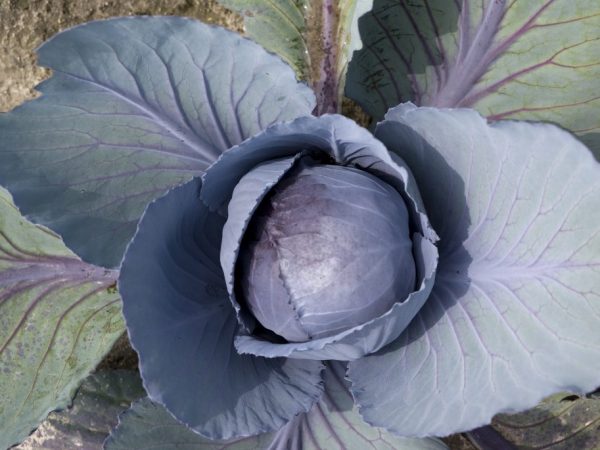
Gako variety keeps well
Gako is a relatively new hybrid with a medium late ripening of the crop. Cabbage stumps are cut after 4-5 months from the moment of sowing seeds for seedlings. Heads of cabbage have a flat-rounded shape, are resistant to cracking, and are well stored. Purple heads with a grayish waxy bloom have a slight bitterness. With prolonged storage, the bitterness of vegetables disappears.
Nurima
Nurima is an early hybrid with a growing season of about 80-85 days. The stumps are dense, rounded, purple. Unlike other varieties, this hybrid has increased resistance to sudden changes in temperature, so it is excellent for growing in the Urals and Siberia. In addition, Nurima is resistant to various diseases of the Cruciferous family.
Stone head 477
Stone head 477 is a mid-season variety characterized by high yields. It has large heads weighing up to 3 kg. With good care and growing conditions, up to 20 kg of heads of cabbage are harvested from 1 hectare. The variety is resistant to diseases and parasites characteristic of the Cruciferous family.
Kalybos
Kalibos is a mid-season hybrid form with a vegetation period of 100-110 days. Cone-shaped heads weighing up to 2 kg are red, when cut - bright purple. The Kalibos variety is appreciated for its unpretentious care and high yield.
Mars
A new hybrid with a medium-late maturation of heads of cabbage is Mars. Its growing season is 4.5-5 months. Heads of cabbage ripen small, weighing up to 1.5 kg. The heads are dense, purple in color, resistant to cracking and disease. The harvest of the Mars variety is appreciated for the excellent taste of the stumps.
Victory
A mid-ripening variety with gourmet taste Pobeda has a maturation period of heads from the moment of sowing seeds to harvesting 3.5-4 months. The rosette is medium in size, the leaves are slightly raised. In the Pobeda variety, heads of cabbage are red, their weight varies from 1.5 to 2 kg.
Faberge
Faberge is a new domestic hybrid of the mid-late maturity of stalks. The growing season is 3-4 months.Heads of cabbage are cone-shaped, purple with a waxy bloom. Faberge hybrid is appreciated for its excellent taste.
Varna
Varna is a new hybrid designed for winter cultivation. Heads of cabbage are purple, round, weighing from 1.5 to 3 kg, ripen from 3 to 4 months. The crop is used for fresh consumption and conservation. During cultivation, the Varna variety is rarely affected by pests and diseases.
Ruby ms
High-yielding variety with good transportability Rubin MS is an achievement of Czech breeders. The variety is classified as mid-season. Heads of cabbage reach 2-2.5 kg. Purple stalks ripen together, are resistant to cracking and disease.
Conclusion
The health benefits of red cabbage are enough to include this vegetable in your daily diet. It practically has no contraindications, has a beneficial effect on the body, skin, nails and contributes to the full growth and development of the child's body. Red cabbage can be used to make both fresh salads and hot dishes.


